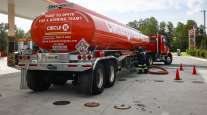Senior Reporter
Diesel Falls 3.2¢ to $2.316; Gasoline Dips 0.9¢ to $2.15

This story appears in the Aug. 15 print edition of Transport Topics.
The U.S. average retail price of diesel fell 3.2 cents to $2.316, according to the Department of Energy, while oil prices continued to hover below $50 a barrel.
Diesel is 30.1 cents cheaper than it was a year ago, when the price was $2.617, DOE said after its Aug. 8 survey of fueling stations.
“Diesel prices have remained remarkably steady, and demand, as DOE measures it, has been pretty poor. You don’t have as much drilling in West Texas, in North Dakota and other places that were diesel-demand intensive when [oil production] was ramping up,” said Denton Cinquegrana, chief oil analyst for the Oil Price Information Service.
Trucking’s main fuel was down in every region.
Meanwhile, the U.S. regular gasoline average price dipped 0.9 cent to $2.15 a gallon — 47.9 cents cheaper than a year ago. It was gasoline’s lowest average price since April 18, when it was $2.137, according to DOE’s Energy Information Administration.
Cinquegrana said that, for refiners, diesel has been “a pleasant surprise this summer, when they were expecting gasoline to be the golden child and it just wasn’t. The diesel refining margins really helped the refiners out.”
EIA reported gasoline production increased last week, averaging 10.1 million barrels per day. Distillate fuel production, including diesel, decreased however, averaging just over 4.7 million barrels.
Despite low fuel prices, there are best practices that can save truckers even more money, said Vickie Roberts, senior vice president of operations for Truckers Solution. “It’s important to learn how to effectively purchase fuel to maximize the bottom line. I can’t stress trip planning enough.”
The biggest mistake she sees is many of the small fleets and owner- operators she works with “just buy fuel strictly on the posted price, just making the decision as the needs arise” and sometimes buying where they have the most reward points, Roberts said.
A gallon of diesel purchased in Georgia based on the posted price would appear cheaper than a gallon with a higher posted price in Florida, she said, but the “reverse is actually true because of the state [fuel] taxes in Georgia and the way drivers get reimbursed for state taxes. … When you take the state taxes out, the gallon is cheaper in Florida than it is in Georgia.”
Truckers pay taxes both at the pump and a prepaid amount based on the mileage they drove in a particular state, Roberts said.
“States then have them do this [quarterly] reconciliation of credits and debits because they pay taxes where they burned the fuel, not where they purchased it. Whenever they purchase fuel, they earn credits. Wherever they burn fuel, they earn debits,” she said.
“Most guys don’t know that. … We are working to educate them on buying net of state tax,” she said.
Truckers Solution also provides fleets and drivers with the ability to reduce expenses such as tires, driver recruiting and document scanning, according to the Clermont, Florida-based company.
Gasoline prices were down in all regions except the Midwest, where it rose 4 cents to $2.115.
“I think we are still on pace for record gasoline demand for 2016, and it is going to beat the previous record set in 2007,” Cinquegrana said. “Even with gasoline demand being as solid, as robust as it has been, you are looking at refinery production that was more than enough to meet it and inventories continue to stack up.”
Summer could end with possibly 225 million to 230 million barrels in U.S. storage, he said. After Labor Day last year, 215 million barrels were in storage.
Cinquegrana added that low retail gasoline prices should continue to “stoke [consumer] demand.”
Meanwhile, crude oil futures on the New York Mercantile Exchange closed Aug. 8 at $43.02 per barrel. That was up from $40.06 on Aug. 1, when West Texas Intermediate crude oil closed 22% below its June peak.




